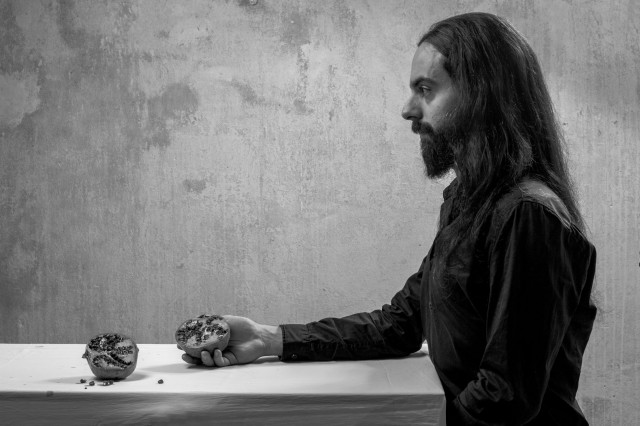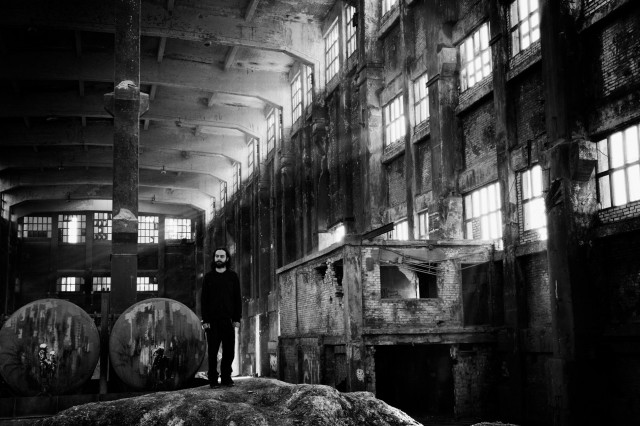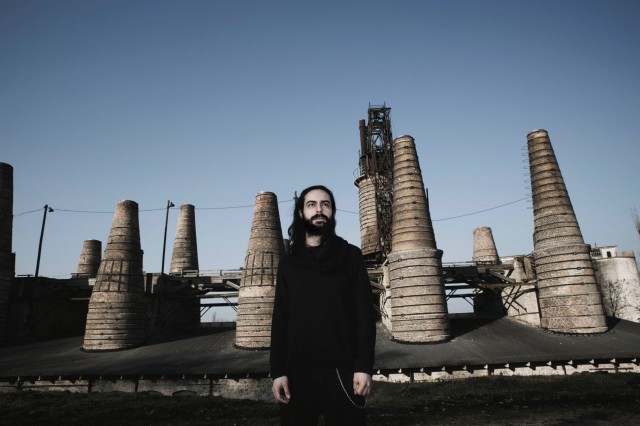Daniele Antezza and Federico Nitti are seated in a patch of grass in the park, lost in reflection like giddy monks.
The conversation turns to archaic geometries from lost civilizations, then to how to let loose unstable configurations of sound, then how to sweep away a party crowd in the whole experience. But, perhaps true to his Mediterranean roots, Daniele’s favorite English word for describing the elements of his work is “taste.”
Inner8 is the project for people whose flavor palette turns to the experimental. Daniele is known to techno fans for his collaboration Dadub with Giovanni Conti. That act is a pillar of the sound of Stroboscopic Artefacts, and the two have a mastering operation – Artefacts Mastering – to match. If Dadub is the street-legal club operation, then, Inner8 is the wild concept car wildly tearing around a test track. And for full immersion, Daniele works with sYn – sound artist and visualist Federico Nitti – to add a live visual component.
Inner8 is both a record album and live show, and accordingly it’s on a label (Undogmatisch) that’s also an art collective and event series. The self-titled album arrived last week.
The record is I think one of the most interesting to be released this year. Far from the rambling experimental norm, here Daniele maintains a sense of focus, heart, direction. The complete record is ready to stream, and comes with a visual accompaniment employing the work of both sYn and artist collaborator Valentina Bardazzi.
Give the full record a listen (thank you, FACT):
We got to sit down with Daniele and Federico to talk signal routing, synesthesia and audiovisual process, and of course, name dropping Electro-Harmonix pedals and exploring the mysteries of the Moebius strip.
You have non-Western musical sources on the record, for example on the third track? What are we hearing there?
Daniele: My fascination with Eastern music comes from my interest in Eastern percussion. I practiced and studied Turkish music for a while, music from Algeria, Morocco. I was fascinated by the way they conceive the groove. If you think about a technique of playing a percussion part in Persia, for example, it’s very complex, but the patterns are easier to understand. It’s beautiful how thinking about those patterns works in the electronic domain. It’s just a groove I really love.
Regarding the samples I used, that’s actually Indian stuff. And I noticed that — I don’t know why — there was something in the harmony that is really Eastern. So I was fascinated about this kind of crossover in traditions and I just tried layering the Middle Eastern taste with these Indian sounds which are really ancient.
In the album, I used mainly samples from one study from an anthropologist made in the 1970s in Africa. It was funny how it all naturally fits with these crazy grooves.
So how did that come about? You had the grooves first and then you listened to the sample, and then you put the two together?
Exactly. I usually never compose grooves or patterns thinking that it’s going to become a track. I just do it because I like it. I like to improvise, to test something for the live set. So I had these patterns and I was listening to this music and thought — this is just perfect! So I just layered them. I used many processes afterwards, of course, but it started like that.
It seems like you’re working with a lot of different colors. There’s harmonic content unfolding in the distortion; it’s not just degrading the material; it’s also creating it. What was your approach to adding distortion?
I’m happy because I spent hours trying to tune in the reverbs, the ambience and the rooms I use in the tracks and so I did the same with the distortion. I wanted to achieve something rough but harmonic. So I just added the layers to the main groove. It was made through a system of distortions and feedbacks. At the end I must admit that the mix is a little bit too clean.
Too clean?
Yes, I wanted to add more character to it, but I will achieve that in my next album.
What’s the problem with it being too clean? Did you want to sound more aggressive or did you want more harmonic distortion?
My attempt was to have a mass of sound but with room. It’s kind of a paradox, because having such a wall of sound, you should sacrifice a little bit of dynamic. That’s why I used many different distortions and 95% of them are digital. I wanted to reproduce the different tastes of distortion, from the most digital to the analog. Mixing this plus my feedbacks, it sounded very rough but never in a destructive way. In the future, I want more mass. I’m just starting to figure out how to achieve it.
What does that processing chain look like?
It’s actually made by many reverbs and distortions plus some envelope follower – some Max for Live device – and all of this is rooted in a drone-generating system. I usually use two systems of reverbs in such a way that it creates a kind of short tails. It creates an interaction between the distortion and patches it with all the other stuff so it sounds coherent.
This is the system I needed to use because the loops I produced for the album are made about seven years ago. I made a different kind of music, had different knowledge; I was in different rooms with different techniques. So I had to create some kind of glue. Now I’m improvising more and working on these two levels – producing loops and effecting them at the same time.
It’s interesting how you work spatially, as well. You talked about using a network of reverbs — maybe it’s a nice side effect of that way of working? How did you conceive what you were working with spatially? There are a lot of sounds from different environments, there’s a lot of motion…
That’s something I’ve learned through experience. In a way, one of the aims I developed with Gio [Giovanni Conti] was to create an environment that surrounds you, but without using a surround system. So we empirically realized that when we work with how our brain perceives the depth, it’s kind of easy to create the surrounding effect. I used these tricks and techniques with Inner8 as well. It’s important because I want my music to create an experience for people. Dealing with the perception of space is important in creating an experience.
Is this something that can work in a stereo club environment? Or is it something that needs to be listened to with headphones?
It depends on the PA. But it could.
Are you doing multichannel versions?
Daniele: To be honest, no. In Undogmatisch, we are working on a launch of proper experimental series of releases. They’re going to be limited versions. The first experiment will be an album with me and Federico. For the next ones, we want to experiment in a technically proper way. We develop our tools, and the first domain to investigate will be the domain of space and perception of depth.
One of the things which is in progress now is to present Undogmatisch out of Berlin. If we manage to do that, the deal is that they have to give us the technical management of the club for that night. We want to route light and sound our own way.
Federico: The idea is to work with both audio and video and also light, perception, atmosphere… and everything should fit together. We’d like to find interesting spaces and make something really special and site-specific for the events.
AV Show by Inner8 and sYn from sYn on Vimeo.
Sound by Inner8
Concept, Programming and Video by sYn
Vectorization and Render by Cubert
Federico, when you compose visually, how do you relate that visual structure to the sound structure? Is it the same sense of phrasing and time, or is it something different?
Federico: Sometimes it’s different; sometimes it’s doing something perfectly consistent with the musician. For example, the work of Kathy Alberici at HAU for the Mouse On Mars anniversary – Kathy showed me her setup and she’s got a feedback system going, loop pedals — and she’s a one man show and building things and adding feedback. And personally, I love feedback.
So you literally translated the audio feedback into visual feedback?
Federico: Exactly. Then I thought: okay, what kind of feedback can I get? I love to experiment, so I thought what would be great to get is a perception that there’s something alive behind the stage, somebody moving, but it wouldn’t be clear if it’s real or if it’s not. So it was about playing with feedback; I put lights behind her and I just used the silhouette of her, then filmed and processed it in real time back on the screen.
With Daniele, I first thought about his name – Inner8. One morning I had a revelation that Inner8 is clearly a moebius – a moebius [strip] with a figure 8 shape. And so the first part of the video is a 3D moebius strip which is completely live-generated and processed live, which is something I really like to do. To me, everything has to be live, I don’t like having things pre-recorded. And the second part is the part of the teaser, which is a study of a pattern. So it’s about being consistent with the work of Daniele.
I researched various patterns coming from different areas like India, Iraq, Persia — all these civilizations. I also researched their use of mathematics and how it was translated into patterns and geometry. The more I was working on it, the more I was amazed by the patterns I found. I studied and analyzed them and put together the most interesting ones to see how they react to each other.
Did this interest in geometry influence the music as well?
Daniele: In this case, unfortunately not, because the material was already done. But the live set was also conceived partly on Mirco [Magnani]’s work. It influenced the next steps in my performance.
In future, this approach must be used for the composition of the tracks. We are also going to do the same kind of work for the next album’s artwork, which we will make together with Valentina [Bardazzi]. We are working on this album with Mirco and me and she’s starting to work on the artwork when we improvise. So in the meantime, we have a full synaesthetic session. And it’s beautiful.
That gets beyond that rational creation of these relationships, right? If people are there to improvise visually, then you have to be connected on a sub-rational, intuitive level.
Yes, definitely. And it is also about choosing the right artists. For me, collaborating with Mirco or Valentina, people who are technically extremely skilled, means that you can be totally free when thinking about art.
Is improvisation something that you’re working with?
Yes. It’s going be more and more about improvisation. Now, when I produce by myself, I can totally improvise, because otherwise it’s a little bit difficult – sometimes I focus on the technical part too much while improvising, which doesn’t work that much.
With Dadub, we enjoy being random when we work on the initial loops. But after that, it’s more about engineering and trying to create weird surroundings and so on. But with Inner8, and with the upcoming album with Mirco, it’s much more about improvisation.
You talked about externalizing things and adding more hardware.
Daniele: Yes, with Inner8 there’s much more hardware. When you know a little bit how to deal with sounds, you can create a sort of an analog taste even when you work with digital tools.
Federico: The computer is also an instrument. You find your way and learn the tools, you find your own sounds and techniques.
Inner8: Yes. But my initial background was also acoustic. I used to play the drums, guitars, bass, percussion. So having sound machines is super natural to me.
What kind of machines – without giving away all your secrets?
I rather meant effects. I just try to reproduce the feedback and generating system I use – in the software, in the digital domain.
So this digital domain is a combination of plug-ins and reverbs and live stuff? What does the hardware look like?
I use a couple of reverbs including the Electro-Harmonix Cathedral reverb. But with some algorithms, you can tune your feedback while you are playing, so you can create patterns on the fly. I really love that sound, it’s super deep. I’m combining this with the Jomox Resonator, with the Superego by Electro Harmonix for freezing and sampling in real time. I like it because that pedal can freeze parts of sounds depending on the amplitude. I also found this really nice pedal by Pigtronix called Philosopher King. I like it because you can trigger with a signal so it’s kind of a side chain with a massive distortion and compression. It gives you the possibility to get really fat sounds. It also routes the envelope to the output. And you can have a responsive system.
Then I have a couple of cheap delays. Now I have to combine all these with my digital chain which is going to be a challenge, because when you try to put too many things together, you have to filter and calibrate and everything.
Metaphysical from Shapednoise on Vimeo.
‘Metaphysical’ is the A/V show of sound artist, Shapednoise, and visual artist, sYn.
Federico, what do your visuals look like? You come from sound background. How do you set things up?
Federico: Well, I got properly into visuals quite late. For a long time, I didn’t know whether to choose sound or photography, but eventually I chose sound. What I like about both disciplines is that you never stop learning. And surprisingly, working on these two things, aesthetics are quite consistent in both disciplines. At some point, you end up making visuals, because you can see the pictures, you can feel the music and they work so well together. I guess I’m lucky because I’m really technical; I like to research and dig things to find the best way to make it work together.
Do you synchronize anything in the A/V shows?
Federico: For the coming shows, yes. We are going to work on sound analysis more. But so far we are both improvising a lot, which is quite special nowadays, to purely improvise live together.
Daniele: I started to learn how to make electronic music because of improvisation. I was always fascinated by that, maybe because I was playing instruments. But when I came to Berlin, I had to dedicate about 90% of my time to sound engineering. Now, I’ve gained a bit of time to be a musician. That’s why I want to dig deeper in the improvisation again.
How much do you take with you for playing live? You obviously don’t have everything you have in the studio… How do bring your album back on and perform it live?
Daniele: I just select four to five effects. Then I need a good mixer and now I still use Ableton to launch my loops, but I’m going to remove it as soon as possible. Maybe in the future, I will also use percussion. But for now, it’s just a mixer for sending the loops and linking the digital chains of effects. That’s easy now, I have only one crossover from the mixer to the digital chain so I can select and route the frequencies. But that’s just a first step; I need to integrate it more.
But I will always, always continue to use the computer. Even if I have a beautiful hardware chain, I sample the sounds and process as much as I can through my digital knowledge. In my opinion, to renounce or say my manifesto is analog is just to say okay I don’t want to see the green. It’s beautiful when you can see all the colors, when you can use all of the tools you have. It’s full of beautiful toys. You have so many possibilities. It’s a system of universes of choices!
Federico, what is your visual rig like when playing live?
Right now, it’s a bloody computer. I like custom things. It’s usually a combination of Max/MSP and Jitter. Max/MSP most of the time for many things, because it’s the logic part. You can just imagine things how you want, just make your own thing. You don’t depend on software that’s closed. My controlling part is written in Max, and I trigger Jitter or I trigger Quartz Composer through VDMX. All the processing, sound analysis, all that is done in Max.
The problem is, you get tired of computers. Future projects, I want to be as analog as possible. But I work on some old analog gear like video mixers, as well – and bends. The idea is to make it as an instrument, a bent instrument with CV and gates, so I can also work with a modular system, dealing with video and sound at the same time, triggering and working with each other. I want to get into electronics. I’m done with computers.
Thank you, gentlemen. Here’s looking forward to the upcoming live show — and everything else Undogmatisch has in store.
https://www.facebook.com/Inner8/
http://aleatory-am.com/e/inner8/
Photos: Kiril Bikov; courtesy Undogmatisch.
Interview editing: Zuzana Friday Přikrylová for CDM.


